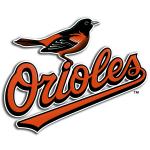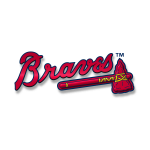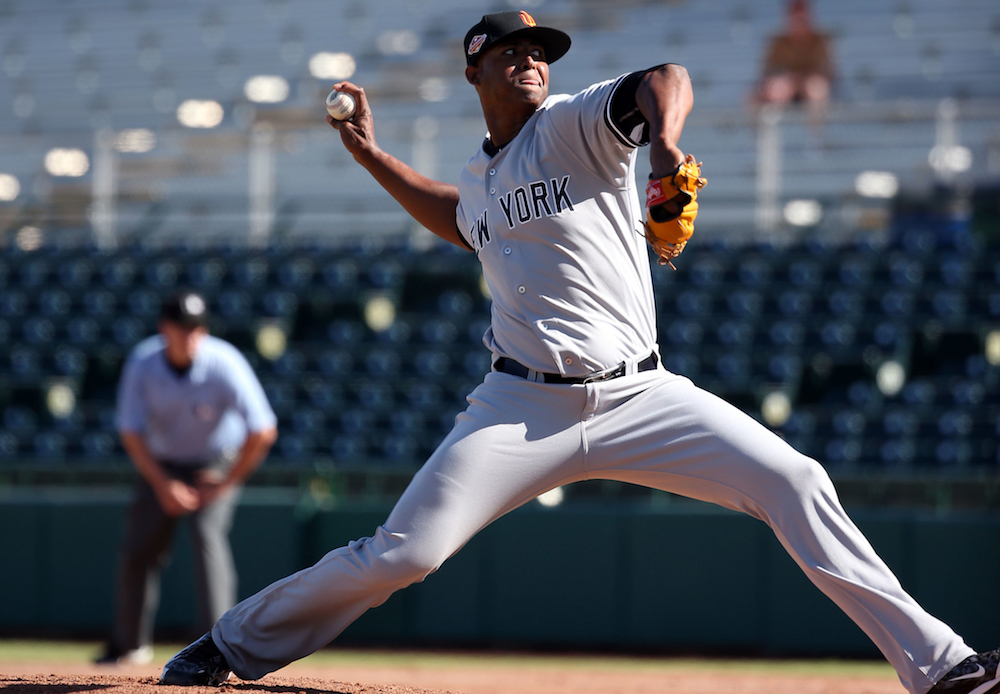Feature Photo: Domingo Acevedo, RHP, Yankees
We’re back this week with in-depth looks at Domingo Acevedo’s (RHP, Yankees) impressive Double-A debut, an update on the Orioles fireballing lefty Tanner Scott, as well as shortstop Ozzie Albies and lefty Sean Newcomb of the Braves. Also, don’t forget to follow our full season of prospect spotlights by bookmarking our 2017 Prospect Spotlight Library, which has 14 new updates, as well as our 2017 Prospect Video Library, which this week added 17 prospects to our growing list of coverage.
2080 Prospect Spotlights
Double-A
 Domingo Acevedo, RHP, Yankees (Double-A Trenton, Eastern League)
Domingo Acevedo, RHP, Yankees (Double-A Trenton, Eastern League)
Ht/Wt: 6’7” / 240 lbs. B/T: R/R Age (as of April 1, 2017): 23 y, 2m
Acevedo was the most electric, strike-throwing power arm I’ve seen at Trenton’s Arm & Hammer Park this season, making his Double-A debut for the Thunder in impressive fashion, throwing 6 1/3 innings and giving up just four hits, two walks and five strikeouts in a 6-0 Thunder win over the Portland Sea Dogs. He sat 94-to-97 mph (T98) with a near-elite, 75-grade fastball all night, with most of my readings at 95-to-96 mph with arm-side run and tail, and with late life. His big-time extension off the mound makes this pitch, and the entire arsenal, play up half a grade when coming out of hand so close to the plate, utilizing and easy arm action that starts calmly with a slight stab in the back and accelerates quickly and smoothly through his 3/4’s arm slot. He established his fastball early to get outs, but five early outs were of the hard-contact variety, as his misses would leak into the zone, in part due to some inconsistent mechanics that had him overthrowing at times, and spinning out to the first-base side.
The swing and miss is in there with his two average secondaries that project to above-average offerings with some polish to the delivery and increased usage. His tumbling changeup sat 82-to-85 mph, and his average slider was 84-to-89 mph, with easy ¾’s-or-better depth and late bite in the lower velo range, and the harder version taking more of a cutter-like dart shape in the 88-to-89 mph range. Each offering was mixed much more effectively the second and third time through the lineup. His overall control profile is easy-plus graded (2.1 BB/9 and 9.9 SO/9 through 93 innings across Class A and High A ball in 2016, and 2.07 SO/9 and 10.75 SO/9 through 47 2/3 innings this year.
He looked every bit the part a future Role 60, number three starter, and he was quickly comparable, to my eye, to the huge frame, soft build, sloped shoulders, and gait of Michael Pineda (RHP,Yankees), just with more juice in the overall stuff. But from a development point of view, he compares well to another electric arm that I saw in the AFL last year in Michael Kopech (RHP, White Sox), in that Acevedo could benefit from calming the fastball down to a consistently plus to double-plus 94-to-95 mph by smoothing his mechanics for improved repeatability and a consistent online finish. That would maintain the control grade at plus, or better, and improve the effectiveness of his secondaries by firing from a more consistent release point, which would make the arsenal even harder to pick up out of hand with the huge extension he gets off the mound. The grades, and the chance for plus-or-better control, make a hell of a starter’s package. – Mark Shreve
 Tanner Scott, LHP, Orioles (Double-A Bowie, Eastern League)
Tanner Scott, LHP, Orioles (Double-A Bowie, Eastern League)
Ht/Wt: 6’2”/220 B/T: R/L Age (as of April 1st 2016): 22y, 9m
Drafted by the Orioles in the sixth round in 2014, Scott was initially assigned to the Rookie GCL Orioles where he made eight starts. Due to inconsistency and significant control issues, the Orioles moved him to the bullpen full time in 2015, with an eye on making him into a multi-inning, leverage reliever. Thus far in 2017, he has a career-low 1.50 ERA to go along with a 12.7 SO/9. That said, he still is consistently missing the plate, with an appalling 7.5 BB/9, and a less than attractive 0.65 GO:AO ratio.
He throws an 80-grade fastball, which sat 96-to-99 mph topped out at 103 mph in my viewing on May 7. His second offering is an average slider with late 3/4’s break, but it was something that he used only when he was ahead in the count – which wasn’t all that often. He also has a changeup that, while he didn’t use it much in this outing, could be an effective pitch for him if he can get it anywhere near the zone just based on it being a change-of-pace offering off of the big fastball.
Scott is very much a thrower who will need to continue to work on getting ahead of hitters to become a pitcher who will extend beyond the role lefty specialist out of the bullpen. He will need to work ahead more often to get to his secondary stuff, and obviously needs to get the walks down to limit traffic on the base paths. If he can continue to build on his early success this season, he has the raw stuff to be an impact arm in the back-end of the bullpen. Here’s a look at Scott from the 2016 Arizona Fall League, courtesy of 2080s Alec Dopp. – Alexis Collins
Triple-A
 Ozzie Albies, SS, Braves (Triple-A Gwinnett, International League)
Ozzie Albies, SS, Braves (Triple-A Gwinnett, International League)
Ht/Wt: 5’9”/160 lbs. B/T: S/R Age (as of April 1st, 2017): 20y, 3m
When it comes to middle infielders, Albies is the ideal prospect. While he is small in stature, he brings significant offensive upside in the form of legitimate gap power, some over-the-fence pop to the pull side, and advanced bat-to-ball skills. Couple all that with his 75-grade run tool, and you have an impact, top-of-the-order bat at a premium position up the middle. Albies has not only been young for the level everywhere he’s been, but he has improved each step of the way — should the Braves be competitive in 2017, Albies is exactly the type of impact energy that could make a huge difference down the stretch.
Through 153 at-bats this season, Albies has improved in almost every offensive category, save walks and strikeouts. His comfort level at the plate currently is second to none, and while the strikeouts are up about 6% from his Triple-A time in 2016, it has more to do with his aggressiveness in the zone and his drive to do more damage than it does a flaw in his approach. Albies is incredibly smooth at the plate, and right now his balance and timing are resulting in a higher hard-contact rate. While he is only walking at a 6.7% rate, he put up some excellent at-bats earlier this week, and we are likely witnessing him now adjusting back to being pitched as a known quantity in the league. On the bases, Albies is a terror — he is a solid 70-grade runner down the line without the jailbreak (3.54 on a bunt), and ticks up to a 75 or 80 underway, as he is really able to find an extra gear. Not only does he go first-to-third as well as anyone, but Albies is almost a lock to score from first on any ball hit into to the gaps.
Admittedly, if Atlanta isn’t winning, it won’t make sense to rush the youngster — however, if the Braves are in the hunt after the all-star break, the energy of Albies could transform that lineup with the pressure his speed and extra-base-hit potential brings to the table — not unlike what Jose Reyes (3B, Mets) did for the Mets lineup as a young player. – Dave DeFreitas
 Sean Newcomb, LHP, Braves (Triple-A Gwinnett, International League)
Sean Newcomb, LHP, Braves (Triple-A Gwinnett, International League)
6’5”/255 lbs. B/T: L/L Age (as of April 1st, 2017): 23y, 9m
Coming over to the Braves as one of the key pieces in the trade that sent Andrelton Simmons (SS, Angels) to Los Angeles before the 2016 season, Newcomb brings big stuff and plus swing-and-miss capability to the table, but is limited by the inability (at least to-date) to limit the walks. Last season for Double-A Mississippi Newcomb struck out 9.77-per- nine innings, and he walked 4.56-per-nine innings, and went six or more innings in only 11 of his 27 starts, while averaging 90-plus pitches per outing. His 60-grade heater sits in the low-to-mid 90s and was up to 96 mph a few times in his last start versus Norfolk. He pairs that with a sharp curveball in the low 80s that shows ingredients to be plus, but the execution is inconsistent and it tends to get loose and takes on a bigger shape. His third pitch is a circle changeup that is firm in the zone and lacks the good dive and velo separation you look for. His arm works very well and he is an athletic kid, so the pitch should develop with time, but he will need to start mixing it in more so that he has options versus big league lineups.
Newcomb is also a fly ball guy (0.76 GO:AO in 2017 and 0.97for his career), which is not a great combo when you’re walking almost five hitters a night — but he has a respectable 7.4 H/9 this season and has only allowed one home run over 42 ⅔ innings pitched. So while the walks are an issue and the fly balls are not ideal, he is keeping the ball off of the barrel and seems able to dial up the put-away pitch when needed.
His walk rate is in line with his 2016 numbers at 4.43 BB/9 – however the strikeouts have spiked a bit to 10.97-per nine. Those two numbers are representative of positive trends, but once again Newcomb isn’t pitching deep into games, as he has only gone more than 5 ⅓ innings twice in eight starts, while averaging about 95 pitches per outing. Newcomb has the stuff to be a very good number four starter at the major league level, however he will have to get more efficient with his pitches and execute on a more consistent basis, lest he get worked over by the more patient big league lineups. – Dave DeFreitas


